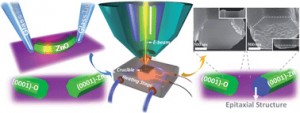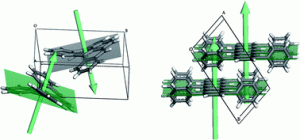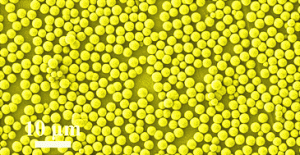 In this CrystEngComm Hot article, Roberto Otero and colleagues from Spain self assemble zinc meso-tetramesitylporphyrin on copper and gold into one-dimensional nanorods.
In this CrystEngComm Hot article, Roberto Otero and colleagues from Spain self assemble zinc meso-tetramesitylporphyrin on copper and gold into one-dimensional nanorods.
Otero explains they are ‘shish-kebab type coordination polymers’, and that they can extend for hundreds of nanometres.
Read the full article for FREE to find out more about these porphyrin nanorods…
Surface assembly of porphyrin nanorods with one-dimensional zinc–oxygen spinal cords
Marta Trelka, Christian Urban, Celia Rogero, Paula de Mendoza, Eva Mateo-Marti, Yang Wang, Iñaki Silanes, David Écija, Manuel Alcamí, Felix Yndurain, Andrés Arnau, Fernando Martín, Antonio M. Echavarren, José Ángel Martín-Gago, José María Gallego, Roberto Otero and Rodolfo Miranda
CrystEngComm, 2011, DOI: 10.1039/C1CE05494E
Keep up to date with the latest news and research in solid-state and crystalline materials: sign up to the CrystEngComm e-alert, follow us on Twitter, and get the RSS feed.












 In this CrystEngComm Hot article Zhimao Yang and co-workers from Xi’an Jiaotong University make copper oxide nanostructures with copper nanoparticles grown on the {111} facets via a one-pot method.
In this CrystEngComm Hot article Zhimao Yang and co-workers from Xi’an Jiaotong University make copper oxide nanostructures with copper nanoparticles grown on the {111} facets via a one-pot method.
 In this HOT article, Chinese researchers synthesized novel polyhedral 26-facet CuS microcages decorated with unique crystalline structures as building blocks via a facile sacrificial Cu2O templates solution route. Each of the polyhedral 26-facet CuS microcages is constructed of three different structural shells, which are enclosed by three pairs of square mesostructural shells, four pairs of nanotwinned triangular shells, and six pairs of rectangular single crystalline shells. The study should be of great importance for the “bottom-up” assembly of unusual hollow ordering superstructures.
In this HOT article, Chinese researchers synthesized novel polyhedral 26-facet CuS microcages decorated with unique crystalline structures as building blocks via a facile sacrificial Cu2O templates solution route. Each of the polyhedral 26-facet CuS microcages is constructed of three different structural shells, which are enclosed by three pairs of square mesostructural shells, four pairs of nanotwinned triangular shells, and six pairs of rectangular single crystalline shells. The study should be of great importance for the “bottom-up” assembly of unusual hollow ordering superstructures. In this CrystEngComm Hot article Joël Moreau and colleagues create a porous network from a host compound based on spirocyclic triphosphazene.
In this CrystEngComm Hot article Joël Moreau and colleagues create a porous network from a host compound based on spirocyclic triphosphazene.


 Guoqi Zhang, Guoqiang Yang and coworkers from the Chinese Academy of Sciences, Beijing make a series of bis(pyrrolyl)carbohydrazide derivatives in this CrystEngComm Hot article.
Guoqi Zhang, Guoqiang Yang and coworkers from the Chinese Academy of Sciences, Beijing make a series of bis(pyrrolyl)carbohydrazide derivatives in this CrystEngComm Hot article. José Giner Planas and colleagues from the Institut de Ciència de Materials de Barcelona (ICMAB-CSIC), and Mark E. Light and Michael B. Hursthouse from the University of Southampton look at methyl-o-carboranyl and o-carboranyl alcohols bearing N-aromatic rings in this CrystEngComm Hot article.
José Giner Planas and colleagues from the Institut de Ciència de Materials de Barcelona (ICMAB-CSIC), and Mark E. Light and Michael B. Hursthouse from the University of Southampton look at methyl-o-carboranyl and o-carboranyl alcohols bearing N-aromatic rings in this CrystEngComm Hot article. In this CrystEngComm Hot article, Roberto Otero and colleagues from Spain self assemble zinc meso-tetramesitylporphyrin on copper and gold into one-dimensional nanorods.
In this CrystEngComm Hot article, Roberto Otero and colleagues from Spain self assemble zinc meso-tetramesitylporphyrin on copper and gold into one-dimensional nanorods.